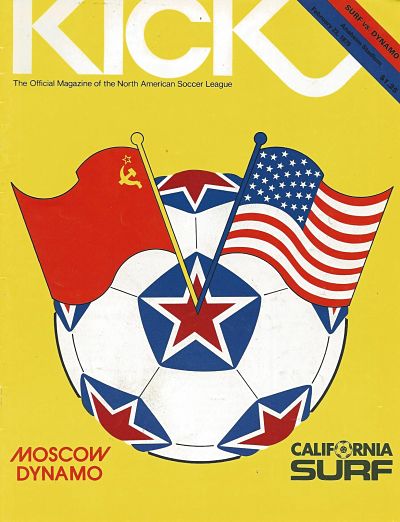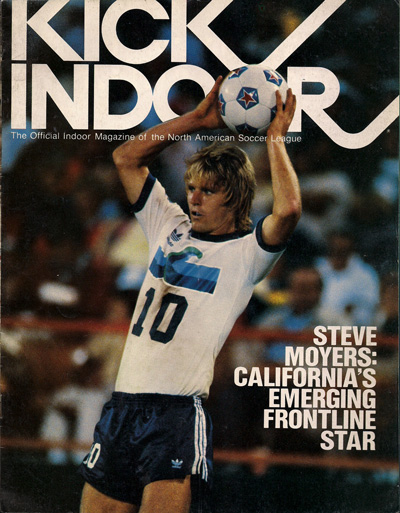North American Soccer League (1978-1981)
Tombstone
Born: October 1977 – The St. Louis Stars relocate to Anaheim, CA
Folded: September 16, 1981
First Game: March 31, 1978 (W 1-0 vs. Portland Timbers)
Last Game: August 19, 1981 (L 5-2 @ San Diego Sockers)
Soccer Bowl Championships: None
Stadia
Outdoor:
Anaheim Stadium (43,200)11978 North American Soccer League Guide
Opened: 1966
Indoor Soccer:
1979-80: Anaheim Convention Center
Opened: 1967
1980-81: Long Beach Arena (10,600)
Opened: 1962
Marketing
Team Colors: Light Blue, Dark Blue & Lime Green21978 North American Soccer League Guide
Ownership
Owners:
- 1978-1980: Robert Hermann, et al.
- 1980-1981: Henry Segerstrom, et al.
Background
The California Surf soccer club was a short-lived and unloved entry in the North American Soccer League (NASL), who played four outdoor and two indoor seasons between 1978 and 1981. The Surf traced their ancestry back to the St. Louis Stars, one of the founding clubs in the National Professional Soccer League in 1967. The following year, the NPSL merged with the rival United Soccer Association to form the NASL.
By 1977, St. Louis Stars owner Bob Hermann was one of only two investors still standing from the original group of soccer backers of the late 1960’s. Lamar Hunt of the Dallas Tornado was the other. But the NASL seemed to be on the rise in 1977. League-wide attendance topped one million fans for the first time in 1975 and continued to grow. Six clubs averaged over 15,000 fans per game, paced by the New York Cosmos, who drew 34,142 per match in their first season at the brand new Giants Stadium in New Jersey. Consequently the Stars’ home ground at Francis Field appeared increasingly inadequate – the stadium held only 10,000 fans.

Boom Town
In October 1977 the NASL approved a transfer of the ten-year old Stars to Anaheim, California and the 43,200-seat Anaheim Stadium. The NASL already had a club in nearby Los Angeles, but Orange County was the epicenter of a youth soccer explosion. League officials salivated over the favorable demographics in Anaheim. Hermann continued as Chairman of the club, and continued to be very active in NASL affairs as Chairman of the league’s Executive Committee.
(Pause for a bit of trivia here – the Hermann Trophy, college soccer’s equivalent of the Heisman Trophy, is named for the former Stars/Surf owner).
Anaheim never turned into the kind of boom town that the NASL hoped for. Attendance peaked in 1978 at 11,171 per match. Most nights found a desolate morgue-like atmosphere at Anaheim Stadium. The Orange County Register frequently jabbed the team, suggesting that even the meager announced attendance figures were inflated. The team itself was a mediocrity, never finishing above .500 or advancing beyond the first round of the NASL’s overly-inclusive playoff format. Although primarily remembered as an outdoor club, the Surf also took part in two NASL indoor soccer seasons in the winters of 1979-80 and 1980-81. Surf indoor matches were played at the Long Beach Arena.

The End
By 1980, midway through the Surf’s third season, it was clear that Orange County’s youth soccer boom had not translated into significant support for professional soccer. Rumors circulated that the Surf would merge with the NASL’s Los Angeles Aztecs, or return to St. Louis, or be sold and shifted to Calgary or New Orleans. Instead, the club was rescued by a consortium of ten Orange County businessmen led by Henry Segerstrom. The group bought up 100% of the team’s stock to keep the team in Anaheim.
The new owners ran the Surf through one winter indoor season (1980-81) and one final demoralizing outdoor season in the summer of 1981. The one noteworthy event of the 1981 season was the team’s acquisition of former Brazilian World Cup captain Carlos Alberto, a world superstar who played on the mighty New York Cosmos teams of the late 1970’s. Despite Alberto’s presence, the Surf posted a franchise-worst 11-21 record and missed the playoffs for the first time. The new investors lost a couple of million dollars and folded the club on September 16, 1981, a few days before the NASL’s Soccer Bowl championship game.
California Surf Shop
Editor's Pick
Rock n' Roll Soccer
The Short Life and Fast Times of the North American Soccer League
by Ian Plenderleith
The North American Soccer League – at its peak in the late 1970s – presented soccer as performance, played by men with a bent for flair, hair and glamour. More than just Pelé and the New York Cosmos, it lured the biggest names of the world game like Johan Cruyff, Franz Beckenbauer, Eusebio, Gerd Müller and George Best to play the sport as it was meant to be played-without inhibition, to please the fans.
The first complete look at the ambitious, star-studded NASL, Rock ‘n’ Roll Soccer reveals how this precursor to modern soccer laid the foundations for the sport’s tremendous popularity in America today.
When you make a purchase through an affiliate link like this one, Fun While It Lasted earns a commission at no additional cost to you. Thanks for your support!
[auction-nudge tool=”listings”]
California Surf Video
California Surf visit the New York Cosmos at Giants Stadium. July 2, 1978
In Memoriam
Midfielder Wolfgang Sunholz (Surf ’78-’80) passed away at the age of 73 on December 29th, 2019. Front Row Soccer remembrance.
Downloads
1978 California Surf ownership group
1978 California Surf Ownership Group
Links
###


